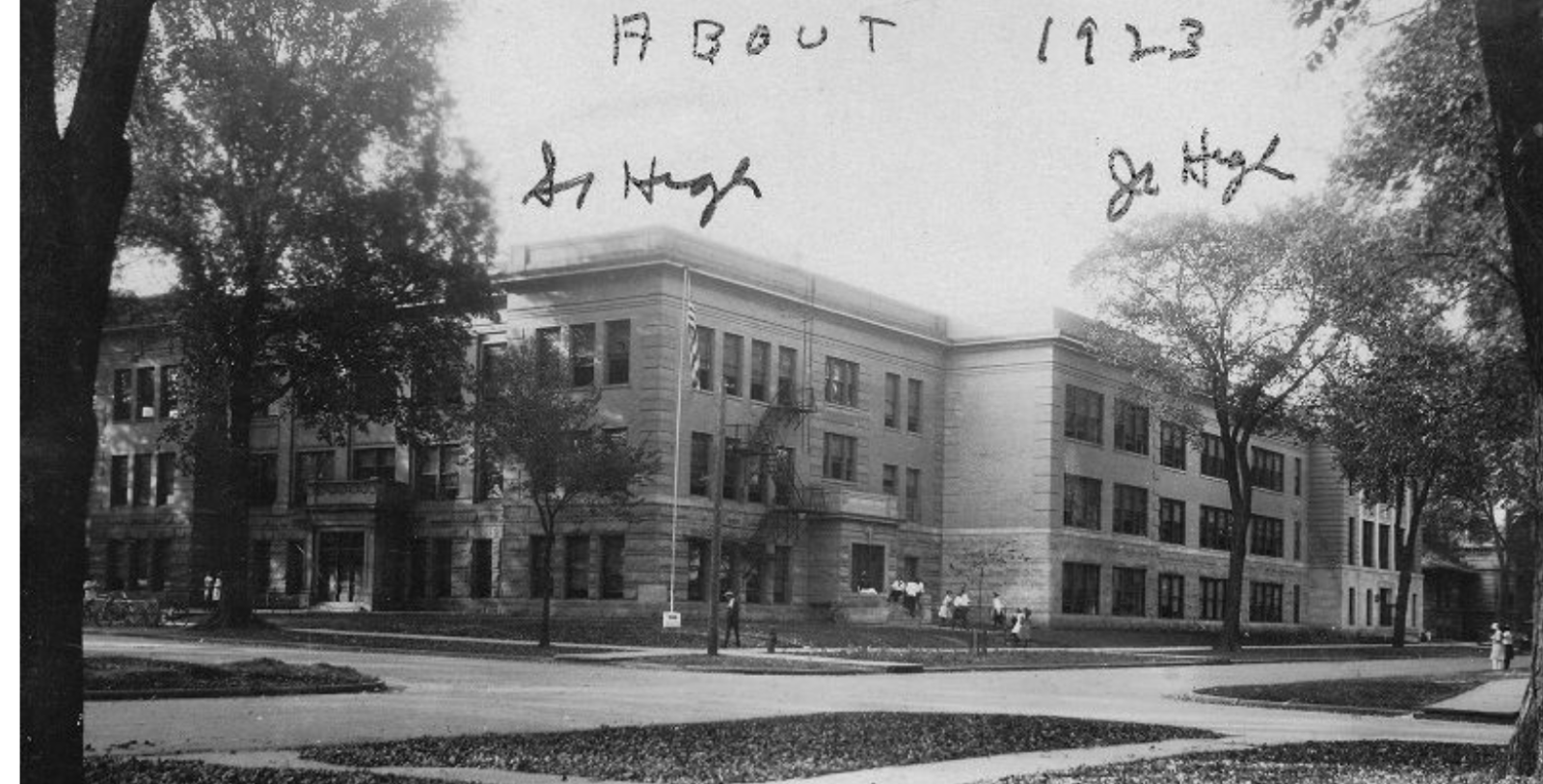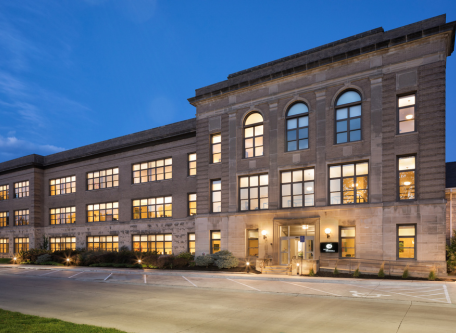Receive for Free - Discover & Explore eNewsletter monthly with advance notice of special offers, packages, and insider savings from 10% - 30% off Best Available Rates at selected hotels.
history
Discover Hotel Grinnell, which was known as the “Grinnell Junior High School” for most of the 20th century.
Hotel Grinnell, a member of Historic Hotels of America since 2023, dates back to 1921.
VIEW TIMELINEAt the start of the 20th century, Grinnell, Iowa, was undergoing a significant cultural renaissance. It had blossomed into a modern city replete with economic opportunity, as numerous warehouses and factories had replaced its rustic log cabins and clapboard storefronts. To accommodate its rapid expansion, Grinnell’s civil servants-initiated dozens of building projects throughout the center of town. Among the communal structures developed was a new junior high school near the intersection of Park Avenue and 4th Street. Meant to function as a semi-autonomous extension to the preexisting Grinnell High School, the junior high building proved to be a considerable project once construction began in 1921. A prominent Des Moines-based architectural firm named “Proudfoot, Bird & Rawson” oversaw its design, which chose beautiful Neoclassical architecture to craft its appearance. The gorgeous structure also stood three stories tall and featured everything from state-of-the-art classrooms to a full-fledged gymnasium. When the work concluded a year later, the new “Grinnell Junior High School” helped make the larger Grinnell High School a precious local landmark. Indeed, the building consistently hosted around 1,000 students annually for the next five decades, its hallways serving as the backdrop for countless memories.
Eventually city officials made the difficult decision to demolish most of the educational compound in 1978, saving only the junior high facility. Grinnell Junior High School then operated on its own before finally reopening as a municipal office space. The former school building even housed the Grinnell City Hall and its affiliated agencies for a while! But in the early 21st century, an ambitious entrepreneur named Angela Harrington purchased the historic structure. Thinking creatively, Harrington determined that the best way to protect the building was to transform it into a wonderful boutique hotel. The planning took years and involved consultation from many experts, including the professionals at the firm Perkins+Will. Harrington’s team also collaborated with various local and state preservationists, who helped provide insight into restoring the structure’s architectural character. Construction then began in 2017, which brilliantly revitalized the entire junior high school into the imaginative “Hotel Grinnell.” Guests marveled at the gymnasium’s clever conversion into a unique ballroom, as well as the widespread use of school-inspired décor in many of the revitalized classrooms-turned-guestrooms. Thanks to Angela Harrington’s innovative stewardship, this amazing historic site is once again one of Grinnell’s most beloved institutions.
-
About the Location: +
Located an hour east of Des Moines, Grinnell, Iowa, is rich in history and culture. Its origins date to the middle of the 19th century when a group of New England Congregationalists first settled the area in 1854. Four Vermonters guided the wagon train to the site, with noted minister Josiah B. Grinnell as their de facto leader. (The legendary journalist Horace Greeley is alleged to have told Grinnell the now-famous quote, “Go West, young man, and grow up with the country.”) Under Grinnell’s watch, the New Englanders gradually developed a rudimentary street grid that they arranged into a collection of residential and commercial neighborhoods. By the eve of the American Civil War, the new town had a variety of specialized stores that offered everything from clothing to books. Three doctors also resided within the town limits, as did four professionally licensed lawyers. Josiah B. Grinnell even founded an institution of higher learning just months after the creation of the settlement, which he called “Grinnell University.” Over time, the school merged with another facility from Davenport called “Iowa College,” forming the nucleus of today’s renowned Grinnell College. To name their new community, Grinnell and the other civic leaders originally wanted to christen it as “Stella.” However, Grinnell engaged in local politicking to have the town named after himself, arguing that his surname was more distinctive and memorable. The community thus adopted the title of “Grinnell,” which quickly became the economic hub for the whole region. Farmers throughout the surrounding Poweshiek County exchanged their agricultural goods in Grinnell for household items and newer farming equipment. Several manufactories subsequently opened, too, especially once the first railroad arrived to help move those products to a wider market in 1863.
Grinnell also obtained significant political importance, serving as a center for the Abolitionist Movement in Iowa. Both Grinnell College and its main benefactor, Josiah B. Grinnell, often promoted anti-slavery politics during the 1850s, giving the town of Grinnell a reputation for its activism. In fact, Grinnell became a stop on the Underground Railroad, with Josiah B. Grinnell occasionally using his own home as a temporary station on the route. (Among the escaped slaves that Grinnell hosted were a group of 12 led by historic abolitionist John Brown.) Despite Grinnell’s great economic and cultural affluence, the town suffered calamities during the late 19th century that caused residents to rebuild multiple times. Nevertheless, the residents endured, resurrecting Grinnell so it was once again one of Iowa’s most prosperous communities by the beginning of the 20th century. Indeed, Grinnell’s neighborhoods teemed with all kinds of new industries, many of which were concentrated in its downtown business district. Perhaps the greatest firm to open at the time was the Spaulding Manufacturing Company. Originally a carriage builder, the Spaulding Manufacturing Company produced countless automobile parts for years! Now a thriving city, Grinnell was a desirable place to live for the rest of the century. In recent years, Grinnell has emerged as a popular vacation spot for contemporary travelers, due to its many historic sites like Grinnell College. (Much of downtown Grinnell is listed in the U.S. National Register of Historic Places as the “Grinnell Historic Commercial District.”) Its proximity to Des Moines has placed it close to additional famed cultural attractions, too, like the Des Moines Art Center, Salisbury House & Gardens, and the Iowa State Capitol. Few places in Iowa can rival the fantastic heritage of Grinnell.
-
About the Architecture: +
The gorgeous building that now houses the Hotel Grinnell was once the junior high school for the area. A prominent Des Moines-based architectural firm named “Proudfoot, Bird & Rawson” oversaw its design, and chose beautiful Neoclassical architecture to craft its appearance. The gorgeous structure also stood three stories tall and featured everything from state-of-the-art classrooms to a full-fledged gymnasium. When the work concluded a year later, the new “Grinnell Junior High School” helped make the larger Grinnell High School a precious local landmark. Hosting around 1,000 children upon its debut, the original building did not have doors or locks. Lockers were also small, giving students space to only hang their coats and hats. A kitchen was absent from the facility, too, since students often traveled home to eat around midday. (A dining hall was later installed following the passage of the National School Lunch Act, which President Harry S. Truman signed into law in 1946.) The special hotel bunkrooms were once athletics offices, while the amazing contemporary ballroom served as a spacious gymnasium. Even the current guestrooms fulfilled a variety of functions back when the school occupied the structure. Room 112 actually operated as the principal’s office and Room 113 was a lounge area for female students. Meanwhile, Rooms 311 to 315 originally constituted the school’s library space, hence the clerestory arched windows that define the area now. Furthermore, the penthouse sitting atop the stage of the former theater was its dressing room!
But in 1978, local school officials determined the high school was inadequate for students and closed it down. Gifting the building to the city, municipal officials started using the facility as a community center. They subsequently utilized the gymnasium for public services, adding more locker rooms and renting out the classrooms as office space. (In fact, the city used the first two floors for their own departments!) Unfortunately, much of the historical architecture was covered during this period. Indeed, most of the historic fabric—with the exception of the theater—was torn out when the city took possession. This proved problematic because the erstwhile school was deemed unfit for historic preservation. The only way to save the building was to get the entire downtown designated as a historic district and the junior high listed as a contributing building. Nevertheless, the entire process of figuring out how to finance the adaptive reuse of the former school took nine years. Once financing was in place the renovation was just 11 months from start to finish. The renovations took great pains to pay homage to the building's past. Each guestroom has a chalkboard and chalk—the hotel has since received some fun messages, art, and many scientific equations from visitors! The in-room guide is fashioned after a school primer notebook and the comment cards are report cards. Keycards are called a “hall pass” and only No. 2 Pencils are featured in the guestrooms. The lounge and patio are also named “The Periodic Table,” which serve cocktails like the “Prom Queen” and the “Lab Partner.” Guest folios are printed on lined notebook paper upon request, too.
Hotel Grinnell today displays a brilliant blend of Classic Revival-style architecture. Also known as “Neoclassical,” Classic Revival design aesthetics are among the most common architectural forms seen throughout the United States. This wonderful architectural style first became popularized at the World’s Columbian Exposition, which was held in Chicago in 1893. Many of the exhibits displayed architectural motifs from ancient societies like Rome and Greece. As with the equally popular Colonial Revival style of the same period, Classical Revival architect found an audience for its more formal nature. It specifically relied on stylistic design elements that incorporated such structural components as the symmetrical placement of doors and windows, as well as a front porch crowned with a classical pediment. Architects would also install a rounded front portico that possessed a balustraded flat roof. Pilasters and other sculptured ornamentations proliferated throughout the façade of the building, as well. Perhaps the most striking feature of Classical Revival-style architecture were its massive columns that displayed some combination of Corinthian, Doric, or Ionic capitals. With its Greco-Roman temple-like form, Classical Revival-style architecture was considered most appropriate for municipal buildings, including courthouses, libraries, and schools. But the aesthetic found its way into more commercial uses over time, such as banks, department stores, and of course, hotels.
-
Famous Historic Guests: +
Amy Tan, author known for books like The Joy Luck Club and The Kitchen God’s Wife.
Joni Ernst, U.S. Senator from Iowa (2015 – present)
Kamala Harris, 49th Vice President of the United States (2021 – present)
Joe Biden, 46th President of the United States (2021 – present)

































